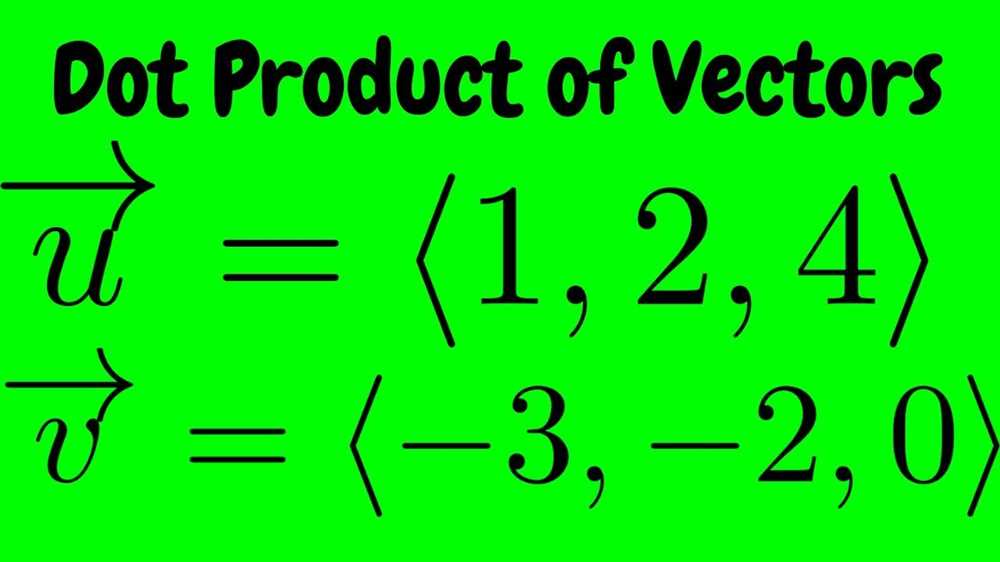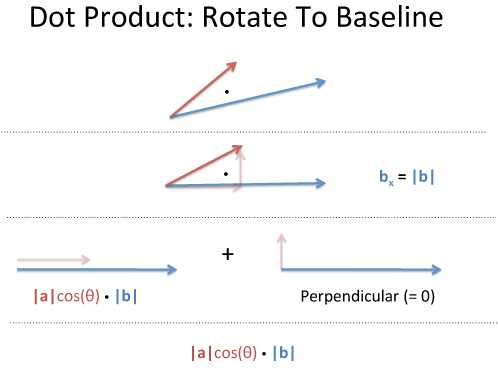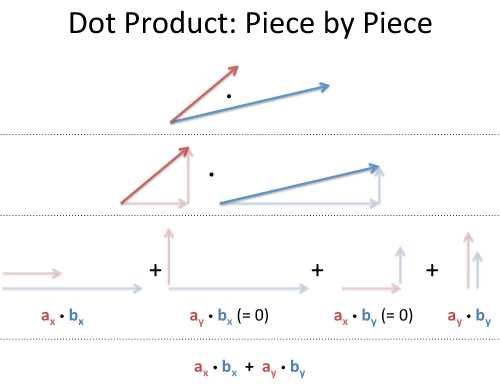
In mathematics, dot products and vector projections are fundamental concepts in vector algebra. They play a crucial role in various fields such as physics, engineering, and computer science. In this article, we will dive deeper into 8.3 Dot Products and Vector Projections and provide detailed answers to help you grasp these concepts.
The dot product, also known as the scalar product, is an operation that combines two vectors to produce a scalar quantity. It measures the similarity or alignment between two vectors. By calculating the dot product, we can determine the angle between vectors and understand their relationship in terms of direction and magnitude.
Furthermore, vector projections involve determining the shadow or projection of one vector onto another. It allows us to find the component of a vector in a specific direction. This concept is particularly useful when analyzing forces acting on an object or finding the closest point on a line to a given vector.
Throughout this article, we will explore various examples and provide step-by-step explanations of how to solve problems involving dot products and vector projections. By the end, you will have a solid understanding of these concepts and be able to apply them confidently in different problem-solving scenarios.
Dot Product Basics

The dot product is a mathematical operation that combines two vectors to produce a scalar. It is also known as the scalar product or inner product. The dot product of two vectors, A and B, is denoted as A · B or A • B.
To calculate the dot product, you multiply the corresponding components of the two vectors and then sum the results. For example, if A = (1, 2, 3) and B = (4, 5, 6), the dot product of A and B would be: 1 * 4 + 2 * 5 + 3 * 6 = 32.
The dot product has several important properties. First, it is commutative, meaning that A · B = B · A. Second, it distributes over vector addition, meaning that (A + B) · C = A · C + B · C. Finally, it is related to the angle between two vectors: if θ is the angle between A and B, then A · B = ||A|| ||B|| cos(θ), where ||A|| and ||B|| are the magnitudes of A and B, respectively.
The dot product can be used to determine if two vectors are orthogonal (perpendicular) to each other. If the dot product of two vectors is zero, then the vectors are orthogonal. For example, if A = (1, 2, 3) and B = (-1, 2, -1), their dot product is: 1 * -1 + 2 * 2 + 3 * -1 = 0. Therefore, A and B are orthogonal.
The dot product also has applications in physics and engineering. It can be used to calculate work done by a force, find the projection of a vector onto another vector, or determine the angle between two vectors in three-dimensional space. Understanding the basics of dot product is crucial for further study in linear algebra and vector calculus.
Definition of Dot Product
The dot product is a mathematical operation that takes two vectors as input and returns a scalar value. It is also known as the inner product or scalar product. The dot product is defined for vectors in any number of dimensions, but for simplicity, we will focus on two- and three-dimensional vectors in this discussion.
To calculate the dot product of two vectors, we multiply the corresponding components of each vector and then sum these products. Specifically, if we have two vectors v = (v1, v2, v3) and w = (w1, w2, w3), the dot product is given by the formula:
- Dot product: v · w = v1w1 + v2w2 + v3w3
The dot product has several important properties. First, it is commutative, which means that the order of the vectors does not matter: v · w = w · v. Second, the dot product is distributive over vector addition, allowing us to factor out scalars: (a v) · w = a (v · w) = v · (a w). Third, the dot product is linear, meaning that it satisfies the equation (v + w) · u = v · u + w · u.
The dot product has many applications in mathematics and physics. It is used to calculate the angle between two vectors, determine if two vectors are orthogonal or parallel, project one vector onto another, and solve systems of linear equations. It is an important tool in vector analysis and plays a key role in understanding the geometry of vectors.
Properties of Dot Products
The dot product is an important operation in vector calculus that produces a scalar. It is defined as the product of the magnitudes of two vectors and the cosine of the angle between them. The dot product has several properties that make it a useful tool in various mathematical and physical applications.
One property of the dot product is its commutativity. This means that the dot product of two vectors is the same regardless of the order in which the vectors are multiplied. Mathematically, this can be expressed as:
- Commutativity: A · B = B · A
Another important property of the dot product is its distributivity over vector addition. This property states that the dot product of a vector with the sum of two other vectors is equal to the sum of the dot products of the vector with each individual vector. Mathematically, this can be expressed as:
- Distributivity: A · (B + C) = (A · B) + (A · C)
The dot product also satisfies the property of being linear with respect to scalar multiplication. This means that the dot product of a vector multiplied by a scalar is equal to the scalar multiplied by the dot product of the vector. Mathematically, this can be expressed as:
- Linearity: r(A · B) = (rA) · B = A · (rB)
Furthermore, the dot product of a vector with itself is equal to the square of its magnitude. Mathematically, this can be expressed as:
- Self-Dot Product: A · A = |A|2
These properties make the dot product a versatile tool in vector calculus and its applications. It allows for the calculation of angles between vectors, determination of orthogonality, projection of vectors, and many other mathematical operations.
Commutative Property
The commutative property is a fundamental property in mathematics that applies to various operations, including addition and multiplication. It states that the order of the numbers does not affect the result when performing these operations.
For addition, the commutative property can be stated as follows: “For any real numbers a and b, a + b = b + a.” This means that the sum of two numbers remains the same regardless of the order in which they are added. For example, 2 + 3 = 3 + 2 = 5.
Similarly, the commutative property also applies to multiplication: “For any real numbers a and b, a * b = b * a.” This means that the product of two numbers is the same regardless of the order in which they are multiplied. For example, 4 * 5 = 5 * 4 = 20.
The commutative property is a useful property in mathematics because it allows us to rearrange terms when simplifying expressions. It provides a convenient way to compute results without having to consider the order of operations. However, it’s important to note that not all operations obey the commutative property. For example, division and subtraction do not follow this property. Therefore, it’s crucial to understand and apply the commutative property correctly depending on the operation being performed.
The Distributive Property
The distributive property is an important concept in mathematics that allows us to simplify expressions and perform calculations more easily. It is applicable in various areas of mathematics, including algebra and arithmetic.
The distributive property states that for any three numbers a, b, and c, the product of a and the sum of b and c is equal to the sum of the products of a and b and a and c. In mathematical terms, it can be expressed as:
a * (b + c) = a * b + a * c
This property can be easily understood and demonstrated with real-life examples. For instance, if you have 3 apples and you want to distribute them equally among 2 people, you can use the distributive property to calculate how many apples each person will receive. By dividing the total number of apples (3) by the number of people (2) and applying the distributive property, you can calculate that each person will receive 1.5 apples.
The distributive property is particularly useful in algebraic simplifications. It allows us to combine like terms and eliminate parentheses, making it easier to solve equations and expressions. By applying the distributive property, we can expand expressions and simplify them to a more manageable form.
In conclusion, the distributive property is a fundamental concept in mathematics that simplifies calculations and helps us solve equations. It is applicable in various mathematical areas and allows us to manipulate expressions and perform calculations more efficiently.
Associative Property
The associative property is a fundamental concept in mathematics that applies to various mathematical operations, including addition and multiplication. This property states that the grouping of numbers or terms within an operation does not affect the final result. In other words, it doesn’t matter how the numbers are grouped as long as the order of operations is maintained.
For example, in the case of addition, the associative property can be stated as:
- (a + b) + c = a + (b + c)
This means that when adding three numbers, the sum will be the same regardless of which two numbers are added first. For instance, if we have the numbers 3, 5, and 7:
- (3 + 5) + 7 = 8 + 7 = 15
- 3 + (5 + 7) = 3 + 12 = 15
Both expressions result in the sum of 15, illustrating the associative property of addition.
The associative property also holds true for multiplication:
- (ab)c = a(bc)
This means that when multiplying three numbers, the product will be the same regardless of the grouping. For example, if we have the numbers 2, 4, and 6:
- (2 · 4) · 6 = 8 · 6 = 48
- 2 · (4 · 6) = 2 · 24 = 48
Both expressions yield a product of 48, demonstrating the associative property of multiplication.
The associative property is a foundational concept that allows mathematicians to manipulate and simplify mathematical expressions without changing their underlying value. It is a property that is used extensively in algebra, calculus, and other areas of mathematics.
Calculating the Dot Product
The dot product is an operation that takes two vectors and returns a scalar value. It is a fundamental operation in vector mathematics and is used in various applications, including physics, computer graphics, and engineering. The dot product can be calculated by multiplying the corresponding components of the two vectors and summing the results.
To calculate the dot product of two vectors, let’s say A and B, we multiply the corresponding components and add the results. If A = [a1, a2, a3] and B = [b1, b2, b3], then the dot product is given by:
A · B = a1 * b1 + a2 * b2 + a3 * b3
This formula can be extended to vectors of any dimension. For example, in three-dimensional space, if A = [a1, a2, a3] and B = [b1, b2, b3], the dot product is:
A · B = a1 * b1 + a2 * b2 + a3 * b3
The dot product can be used to find the angle between two vectors or to calculate the projection of one vector onto another. It is an important concept to understand in linear algebra and vector calculus.
Formula for Dot Product

In mathematics, the dot product is a binary operation that takes two vectors and returns a scalar. It is also known as the inner product or scalar product. The dot product of two vectors is calculated by multiplying the corresponding components of the vectors and then summing up the results.
The formula for calculating the dot product of two vectors, A and B, is as follows:
A · B = |A| |B| cos(θ)
Where A · B represents the dot product of A and B, |A| and |B| are the magnitudes (lengths) of vectors A and B, and θ is the angle between the two vectors.
The dot product formula can be used to determine if two vectors are orthogonal (perpendicular) to each other. If the dot product of two vectors is zero, then the vectors are orthogonal. Conversely, if the dot product is nonzero, then the vectors are not orthogonal.
Additionally, the dot product can be used to find the projection of one vector onto another. The projection of vector A onto vector B, denoted as projBA, can be calculated using the formula:
projBA = (A · B) / |B|
This formula allows us to find the component of vector A that lies in the direction of vector B.
Example Calculation

In order to understand the concept of dot products and vector projections, let’s consider a specific example. Suppose we have two vectors:
- Vector A: [2, 3, -1]
- Vector B: [4, -2, 5]
Now, let’s first calculate the dot product of these two vectors. The dot product is obtained by multiplying the corresponding components of the vectors and summing them up. So, in this case, the dot product of Vector A and Vector B can be calculated as follows:
| A1 * B1 | 2 * 4 = 8 |
| A2 * B2 | 3 * -2 = -6 |
| A3 * B3 | -1 * 5 = -5 |
Summing up these results, we get:
A * B = 8 + (-6) + (-5) = -3
Next, let’s calculate the vector projection of Vector A onto Vector B. The vector projection is obtained by multiplying the dot product of the two vectors by the unit vector of Vector B. The formula for calculating the vector projection is:
Projection of A onto B = (A * B) * (B / ||B||)
Where ||B|| represents the magnitude (or length) of Vector B. In this case, the magnitude of Vector B can be calculated as:
||B|| = √(4^2 + (-2)^2 + 5^2) = √(16 + 4 + 25) = √45 = 6.708
Now, let’s calculate the vector projection:
Projection of A onto B = (-3) * ([4/6.708, -2/6.708, 5/6.708])
Simplifying the calculation, we get:
Projection of A onto B ≈ (-0.447, 0.223, -0.559)
Therefore, the vector projection of Vector A onto Vector B is approximately (-0.447, 0.223, -0.559).


